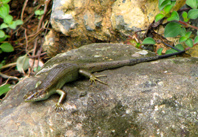Abstract
We describe an extinct species of snipe (Gallinago kakuki, new species) from late Quaternary fossils in the Bahamian Archipelago (Abaco, New Providence, Little Exuma, Long, and Middle Caicos islands). The new species is known as well from fossils on Cuba, and Cayman Brac in the Cayman Islands. This rather large species of snipe was volant, although because of its relatively short carpometacarpus, the primary flight feathers probably were short. The only other species of Gallinago from the West Indies is the extant, migratory G. delicata, which breeds only in North America. Gallinago kakuki shares more osteological characters with two Eurasian species (G. media, G. hardwickii) than with either of the New World species we examined (G. delicata, G. paraguaiae). A possible inter-hemispherical relationship has been proposed as well for the two extinct, late Quaternary species of woodcocks from the West Indies (Scolopax anthonyi of Puerto Rico, S. brachycarpa of Hispaniola).
References
Bard, E., Hamelin, B. & Delanghe-Sabatier, D. (2010) Deglacial meltwater pulse 1B and Younger Dryas sea levels revisited with boreholes at Tahiti. Science, 327, 1235–1237.
http://dx.doi.org/10.1126/science.1180557
Baumel, J.J., King, A.S., Breazile, J.E., Evans, H.E. & Vanden Berge, J.C. (Eds.) (1993) Handbook of Avian Anatomy: Nomina Anatomica Avium. Nuttall Ornithological Club, Cambridge, Massachusetts, 779 pp.
Brodkorb, P. (1959) Pleistocene birds from New Providence Island, Bahamas. Bulletin of the Florida State Museum, Biological Sciences, 4, 349–371.
Bull, J. (1974) Birds of New York State. Cornell University Press, Ithaca, New York, 703 pp.
Clark, P.U. & Mix, A.C. (2000) Ice sheets by volume. Nature, 406, 689–690.
http://dx.doi.org/10.1038/35021176Cohen, K.M., Finney, S.C., Gibbard, P.L. & Fan, J.-X. (2013) The ICS International Chronostratigraphic Chart. Episodes, 36, 199–204.
Franz, R. & Franz, S.E. (2009) A new fossil land tortoise in the genus Chelonoidis (Testudines: Testudinidae) from the northern Bahamas, with an osteological assessment of other Neotropical tortoises. Bulletin of the Florida Museum of Natural History, 49, 1–44.
Gibson, R. & Baker, A. (2012) Multiple gene sequences resolve phylogenetic relationships in the shorebird suborder Scolopaci (Aves: Charadriiformes) Molecular Phylogenetics and Evolution, 64, 66–72.
Howard, H. (1929) The avifauna of Emeryville Shellmound. University of California Publications in Zoology, 32, 301–394.
Mayr, E. (1963) Gallinago versus Capella. Ibis, 105, 402–403.
Morgan, G.S. (1994) Late Quaternary fossil vertebrates from the Cayman Islands. In: Brunt, M.A. & Davis, J.E. (Eds.), The Cayman Islands: Natural History and Biogeography. Kluwer Academic Publishers, Dordrecht, pp. 465–508.
http://dx.doi.org/10.1007/978-94-011-0904-8_22Morgan, G.S. & Albury, N.A. (2013) Cuban crocodile. Bulletin of the Florida Museum of Natural History, 52, 161–236.
Olson, S.L. (1976) Fossil woodcocks: an extinct species Puerto Rico and an invalid species Malta (Aves: Scolopacidae: Scolopax). Proceedings of the Biological Society of Washington, 89, 265–274.
Olson, S.L. (1987) On the extent and source of instability in avian nomenclature, as exemplified by North American birds. Auk, 104, 538–542.
http://dx.doi.org/10.2307/4087560Olson, S.L. & Hilgartner, W.B. (1982) Fossil and subfossil birds from the Bahamas. Smithsonian Contributions to Paleobiology, 48, 22–56.
Ridgway, R. (1919) The birds of North and Middle America, part VIII. United States National Museum Bulletin, no. 50, 1–852.
Steadman, D.W., Albury, N.A., Kakuk, B., Mead, J.I., Soto-Centeno, J.A., Singleton, H.M. & Franklin, J. (2015) The vertebrate community on an ice-age Caribbean island. Proceedings of the National Academy of Sciences USA, 112, E5963–E5971.
http://dx.doi.org/10.1073/pnas.1516490112Steadman, D.W. & Franklin, J. (2015) Changes in a West Indian bird community since the late Pleistocene. Journal of Biogeography, 42, 426–438.
http://dx.doi.org/10.1111/jbi.12418Steadman, D.W., Morris, J.R. & Wright, N.A. (2013) A new species of Late Pleistocene rail (Aves: Rallidae) from Abaco, The Bahamas. Paleontological Journal, 47, 1355–1364.
http://dx.doi.org/10.1134/s0031030113110130
Steadman, D.W., Franz, R., Morgan, G.S., Albury, N.A., Kakuk, B., Broad, K., Franz, S.E., Tinker, K., Pateman, M.P., Lott, T.A., Jarzen, D.M. & Dilcher, D.L. (2007) Exceptionally well preserved late Quaternary plant and vertebrate fossils from a blue hole on Abaco, The Bahamas. Proceedings of the National Academy of Sciences USA, 104, 19897–19902.
http://dx.doi.org/10.1073/pnas.0709572104Steadman, D.W. & Takano, O.M. (2013) A late-Holocene bird community from Hispaniola: Refining the chronology of vertebrate extinction in the West Indies. The Holocene, 23, 934–942.
http://dx.doi.org/10.1177/0959683613479683Strauch, J. (1978) The phylogeny of the Charadriiformes (Aves): a new estimate using the method of character compatibility analysis. Transactions of the Zoological Society of London, 34, 263–345.
http://dx.doi.org/10.1111/j.1096-3642.1978.tb00375.xSuárez, W. (2004) The enigmatic snipe Capella sp. (Aves: Scolopacidae) in the fossil record of Cuba. Caribbean Journal of Science, 40, 155–157.
Takano, O.M. & Steadman, D.W. (2015) A new species of woodcock (Aves: Scolopacidae: Scolopax) from Hispaniola, West Indies. Zootaxa, 4032 (1), 117–126.
http://dx.doi.org/10.11646/zootaxa.4032.1.6Van Gils, J. & Wiersma, P. (1996) Family Scolopacidae (Sandpipers, Snipes, and Phalaropes) species accounts. In: del Hoyo, J., Elliott, A. & Sargatal, J. (Eds.), Handbook of the Birds of the World. Vol. 3. Lynx Edicions, Barcelona, pp. 488–533.
Wetmore, A. (1937) Bird remains from caves on Great Exuma Island in the Bahamas. Bulletin of the Museum of Comparative Zoology, 80, 427–441.
http://dx.doi.org/10.1111/j.1474-919x.1958.tb00371.xWetmore, A. (1958) The Brissonian name for the snipe. Ibis, 100, 125–127.
http://dx.doi.org/10.1111/j.1474-919X.1958.tb00371.xWright, N.A. & Steadman, D.W. (2012) Insular avian adaptations on two Neotropical continental islands. Journal of Biogeography, 39, 1891–1899.
http://dx.doi.org/10.1111/j.1365-2699.2012.02754.xWright, N.A., Steadman, D.W. & Witt, C.A. (2016) Predictable evolution toward flightlessness in volant island birds. Proceedings of the National Academy of Sciences, 113 (17), 4765–4770.
http://dx.doi.org/10.1073/pnas.1522931113

